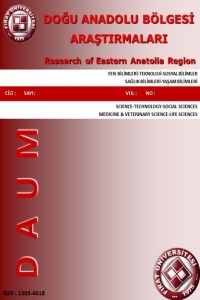MENTAL KONSANTRASYON ÇALIŞMALARININ BİLEK GÜREŞİ ERKEK SPORCULARININ REAKSİYON ZAMANLARINA ETKİSİ
Bu
çalışmada, 20-22 yaş grubundaki 24 bilek güreşi sporcusunun uyguladığı mental
konsantrasyon çalış-malarının, reaksiyon
zamanı üzerine etkisi araştırılmıştır.
Çalışmaya
12’si deney grubu 12’si ise kontrol grubu olmak üzere, toplam tüm sağlık
kontrolleri yapılmış 24 gönüllü bilek güreşi sporcusu katılmıştır. Deney ve
kontrol grubuna konsantrasyon egzersiz programına baş-lama öncesinde ki ilk
haftada görsel ve işitsel ayırt edici reaksiyon zamanı ilk ölçümleri yapılmış,
daha sonra program bitimini takip eden ilk haftada da son ölçümler tekrarlanarak
değerlendirilmiştir. Denek grubuna normal egzersiz programlarının yanında,
haftanın 3 günü, her bir günde 12 seans (6 seans sarı daire, 6 seans beyaz
kare) birer saatlik zaman periyotlarında, 4 hafta uygulanacak yantra kart
konsantrasyon çalışmaları yaptırılmıştır. Kontrol grubu ise, haftalık bilek
güreşi egzersiz programlarına devam etmiştir.
Her
iki grupta da istatistiksel olarak anlamlı gelişmeler kaydedildi. Ancak, deney
grubu kontrol grubuna oranla üç kez daha büyük bir gelişim ortaya koymuştur ve
her iki grubun gelişim oranları arasındaki fark, istatistiki olarak anlamlı
bulunmuştur (p<0.01).
Reaksiyon
zamanının optimum düzeylere ulaştırılmasında diğer metodların yanı sıra mental
yöntemlerin de kullanılmasının yararlı olabileceği söylenebilir.
Anahtar Kelimeler:
Konsantrasyon, Reaksiyon Zamanı, Bilek Güreşi, Spor
___
- 1. Agnew, J., Schwartz, B.S., Bolla, K., Ford, D.P., Blecker, M.L. (1991);“Comparison of Compute-rized and Examiner-Administered Neurobehavi-oral Testing Techniques J Occup Med., 33(11), 1156-62.
- 2. Alper, R., Amado, S., Moralı, S., 2002;”Spor Yapan ve Yapmayan Grupların Konsantrasyon ve Motivasyon Düzeyleri Yönünden Karşılaştı-rılması”, XII. Ulusal Psikoloji Kongresi. 9-13 Eylül Ankara.
- 3. BelI, D.G., Jacops, L. (1986); “Electro-Mecha-nical Responce Times and Rate of Force Development in Males and Females” Med Sci Sports Exerc, 18(1), 31-35.
- 4. Bloxham, C.A., Dick, D.J., Moore, M. (1987); “Reaction Times and Attention in Parkinson 4s Disease”. Journal of Neurology and Psychiatrl, 50,1178-1183.
- 5. Bompa, T.O. (1990); Theory and Methodology of Training. Seconded., Dubuque, Lowa, Ken-dall Hunt Publishing 00., 316, 318-319, 328.
- 6. Colgate, T.H.P. (1968); “Reaction and Responce Times İndividualy Reacting to Auditory, Visual, and Tactile Stimuli. The Research Quarterly, 39 (3), 786-734.
- 7. Cratty, B.J. (1984). Psychological Preperation and Athletic Excellence. Ithaca, N.Y., Move-ment Publications, 103.
- 8. Çolakoğlu, H., Akgün, N., Yalaz, G., Ertat, A. (1987); “Sürat Antrenmanlarının Akustik ve Optik Reaksiyon Zamanlarına Etkisi. Spor He-kimliği Dergisi 22 (1), 37-46.
- 9. Çolakoğlu, M., Tiryaki, Ş., Moralı, S., 1993; ”Konsantrasyon çalışmalarının Reaksiyon Zama-nı Üzerine Etkisi, Hacettepe Üniversitesi Spor Bilimleri Dergisi,(4) 4, (32-47).
- 10. Dostal, E., Kodejs, M., Moravec, P., Noseck, NM., Ruzicka, J., Susanka, P. (1988); “The 1987 International Athletic Foundation/IAAF Scienti-fic Project Report-Time Analysis of the 100 Metres Events at the II.World Championships in Athletics” New Studies in Athletics. 3, 61-98.
- 11. Fischer, B., Weber, H. (1990); “Saccadic Reac-tion Times of Dyslexic and Age-Matched Normal Subjects;Perception, 19(6), 850-18.
- 12. Gardner, F.L.2001; “Applied Sport Psychology in Professional Sports”, The Team Psychologist, Professional Psychology; Research and Practice, February Vol.32 No 1, 34-39.
- 13. Grunberger, J., Saletu, B., Linzmayer, L., Barba-noj, M.J. (1993); “Clinical-Pharmacological Study With the Two İsomers (d-, 1-) of Fenflura-mine and İts Comparison With Chlorpromazine and d-Amphetamine: Psychometric and Psycho-physiological Evaluation.” Methods Find Exp Ciin Pharmacol. 15(5), 313-28.
- 14. Harre, D. (1973). Trainingslehre. Sportverlag, Berlln.
- 15. Harris D.V., Harris B.L., (1984) Sports Psycho-logy: Mental Skills for Physical People; Newyork, N.Y: Leisure Press, 82, 90.
- 16. Jeyaratnam, J., Boey, K.W., Ong, C.N., Chia, C.B., Phoon, W.Q. (1986); “Neurophysiological Studies on Lead Workers in Singapore” Br J. Ind Med, 43(9), 626-9.
- 17. Klinger, E., Barba, S.V., Glass, R.A. (1981); “Thought Content and Gap Time in Basketbail” Cognitive Theraphy and Research, 5, 109- 114.
- 18. Magil, R.A. (1989); Motor Learning. Thirded., Dubuque, lowa, W.C. Brown Publishers, 20-21.
- 19. Maidikov, L., Makarenko, N.V., Kolchenko, N.V. (1986); “Human Higher Nervous Activity During Adaptation to Moderate Altitude” Zh Vyssh Derv Deiat, 36(1), 12-9.
- 20. Nidifter. R.M. (1978); Relationship of Attention and Anxiety to Performance: In Sport Psycho-logy: An Anaiysis of Athletic Behaviour. Ithaca, NY: Movement Publications.
- 21. Nöcker, J. (1971); Physiologie der Libesungen. Ferdinand Enke Verlag, Stuttgart, 262.
- 22. Pashler, H. (1991); “Shifting Visual Attention and Selecting Motor Responses: Distınct Atten-tional Mechanisms” J. Exp Psychol Hum Percept Perform. 17(4), 1023-40.
- 23. Ricci, B. (1967); Physiological Basis on Human Performans. Philadelphia, Lea and Febiger, 50.
- 24. Ricci, B. (1970); Experiments in the Physiology of Human Performans. Philadelphia, Lea and Febiger, 75.
- 25. Saletu, B., Grunberger, J., Anderer, P., Linzmayer, L., Semlitsch, H.V., Magni, G. (1992); Pharmacodynamics of Venlafaxine Evaluated by EEG Brain Mapping, Psycometry and Psychophysiology”, Br J Ciin Pharmacol., 33(6), 589-601.
- 26. Schmidt, R.,A. (1988); Motor Control and Learning. Champaign, Luinois, Human Kinetics Publishers mc., Second ed., 64-65.
- 27. Schweitzer, L.R. (1991); Binary-Choise Decisi-on Time Depends Upon Cerebral Hemisphere and Nature of Task. Percept Mot SkiIIs 73 (1), 147-161.
- ISSN: 1303-4618
- Başlangıç: 2002
- Yayıncı: Fırat Üniversitesi
Sayıdaki Diğer Makaleler
ÖRGÜTSEL ÇATIŞMANIN VE PERFORMANS DEĞERLEMENİN İŞGÖREN PERFORMANSINA ETKİLERİ
GÜNÜMÜZDE TÜRKİYE’DE SİNEMA FİLMLERİYLE TELEVİZYON DİZİLERİNDE KADINLAR VE TÖRE
Cebrahil TÜRK, Ünal İSPİR, Muhammet Enis YONAR
HAZAR GÖLÜ SU KALİTESİNİN ZAMANLA DEĞİŞİMİ
Ayhan ÜNLÜ, Fatih ÇOBAN, Müslün Sara TUNÇ
Mehmet KAYA, Nuri ORHAN, Bülent KURT
YUKARI FIRAT BÖLGESİ’NDE 2006 YILI YÜZEY ARAŞTIRMALARINDA TESBİT EDİLEN İKİ YENİ URARTU KAYA MEZARI
